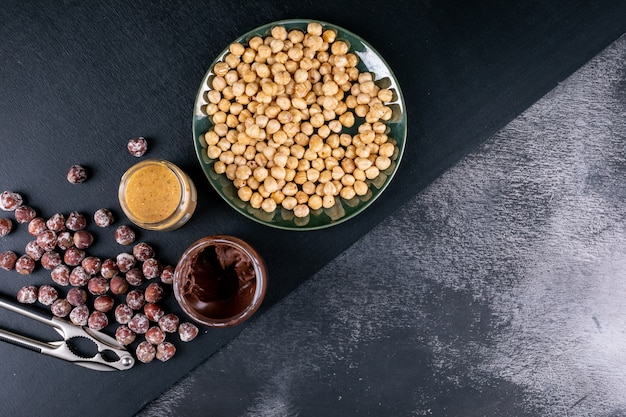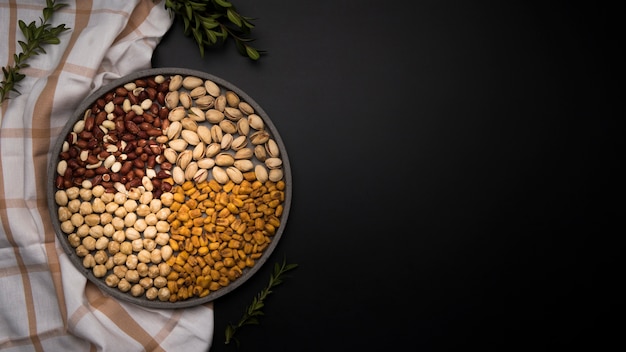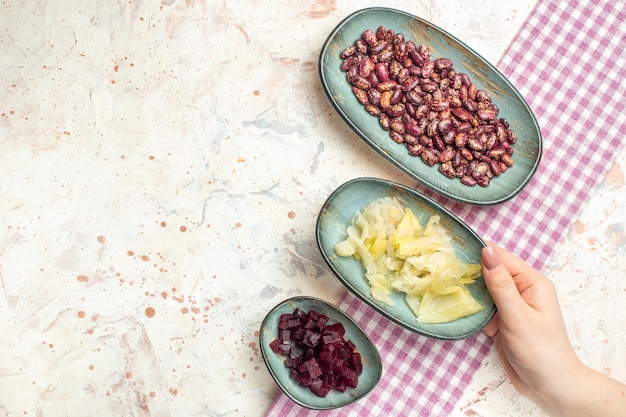Let's talk chickpeas! Not just any chickpeas, mind you, but the perfect ones. You know, the kind that melt in your mouth in a creamy hummus, or add that satisfying crunch to your salads. I've been on a bit of a chickpea journey myself, and let me tell you, there's a world of difference between good chickpeas and truly great ones. So, buckle up, my fellow foodies, because I'm about to share all the secrets I've learned about achieving chickpea perfection.
This guide will take you through the entire process, from selecting the right chickpeas to mastering the soaking and cooking techniques. We'll even explore the different ways you can use your perfect chickpeas, from traditional dishes to modern twists. So, whether you're a seasoned cook or just starting out, grab a cuppa, get comfy, and let's embark on this chickpea adventure together.
(Part 1) Choosing Your Chickpeas

The first step to cooking perfect chickpeas is choosing the right ones. Now, I know what you're thinking: "Isn't a chickpea a chickpea?". Well, not quite. There are subtle differences that can affect the taste and texture of your final dish, and you want to start with the best possible foundation.
The Importance of Freshness
Firstly, let's talk freshness. You want those chickpeas to be fresh, not sitting on a shelf for months on end. Think of it like buying fresh produce. The fresher the chickpeas, the better the flavour and texture. Always check the packaging date and try to choose the freshest batch you can find. If you're buying loose chickpeas from a market, give them a good look-over. You want them to be a uniform, pale beige colour and free from any discolouration or blemishes. You can even give them a little sniff – they should smell fresh and earthy, not stale or musty.
Organic vs. Conventional: A Matter of Choice
Next up, the organic vs. conventional debate. This is a personal choice, but I usually go for organic whenever possible. I feel good about supporting sustainable farming practices, and let's be honest, sometimes the flavour just seems a bit brighter. But if you're on a budget, conventional chickpeas will do just fine. Ultimately, the choice is yours!
The Big Decision: Canned vs. Dry
Now, here's the big question: canned or dry? This is where things get really interesting. canned chickpeas are super convenient, they're ready to use straight out of the can. But let me tell you, there's a certain magic to cooking chickpeas from scratch. The flavour is just richer, the texture more satisfying, and you have complete control over the saltiness. I'm a firm believer that dry chickpeas are the way to go for the best results, but we'll talk more about that later. We'll explore the pros and cons of each choice, so you can make the best decision for your needs.
(Part 2) Soaking and Cooking: The Heart of the Process

So, you've chosen your perfect chickpeas. Now comes the crucial soaking and cooking stage. This is where the real magic happens, and it's surprisingly simple. It's all about transforming those humble chickpeas into something truly extraordinary.
Soaking: The Foundation for Perfection
Soaking is essential. It's not just about making the chickpeas easier to cook; it's about enhancing their flavour and texture. Imagine a dry sponge. It doesn't really do much until you soak it in water. The same goes for chickpeas! The soaking process allows the chickpeas to absorb water, plump up, and soften. This creates a much more tender and flavorful chickpea. It also helps to remove any impurities or dust from their surface.
How to Soak Like a Pro
To soak your chickpeas, you'll need a large bowl and plenty of cold water. I usually use a ratio of about 1 cup of chickpeas to 3 cups of water. Give the chickpeas a good rinse before you add them to the water. This removes any loose debris. Then, cover the bowl with a lid or cling film and pop it in the fridge for at least 8 hours, or even better, overnight. This allows the chickpeas to soak slowly and evenly.
Cooking: The Art of Patience
Once your chickpeas are soaked, it's time to cook them. This is where you can really transform those humble chickpeas into something extraordinary. Remember, patience is key here!
A Simple Method for Success
After soaking, drain the chickpeas and transfer them to a large pot. Add fresh water, about 2-3 inches above the chickpeas, and bring the pot to a boil. Reduce the heat to a simmer, cover the pot, and cook for about 1.5-2 hours, or until the chickpeas are tender but not mushy. You should be able to easily crush a chickpea between your fingers. If you're using a pressure cooker, the cooking time can be reduced significantly to about 30-45 minutes. Just follow the manufacturer's instructions.
Salt: The Finishing Touch
Right before the chickpeas are ready, it's time to add some salt. This isn't just for flavour; it actually helps the chickpeas hold their shape better. I usually add a teaspoon or two of salt, depending on my recipe. You can also add other herbs and spices at this stage, if you like.
(Part 3) Using Your Perfect Chickpeas: A World of Possibilities

Okay, so you've got your perfect, cooked chickpeas. Now, the fun part: figuring out what to do with them! The possibilities are endless, and I've got a few ideas to get you started.
Classic Chickpea Delights: A Taste of Tradition
Let's start with the classics. Chickpeas are a staple in many cuisines around the world, and for good reason. Their versatility makes them perfect for a wide range of dishes.
Hummus: The King of Chickpea Dishes
Where would we be without hummus? This creamy, garlicky dip is a true chickpea masterpiece. You can find countless hummus recipes online, but my favourite involves a combination of tahini, lemon juice, garlic, and spices. It's the perfect snack, dip, or even a spread for sandwiches. The beauty of hummus is that you can customize it to your taste, adding different spices, herbs, and even roasted vegetables.
Falafel: A Crispy Chickpea Treat
Falafel, those crispy chickpea fritters, are another classic chickpea dish. They're perfect for wrapping in a pita bread with tahini sauce, vegetables, and hummus. You can find falafel at many Middle Eastern restaurants, but they're also surprisingly easy to make at home.
Chana Masala: A Spicy chickpea curry
For a warming, flavour-packed dish, try chana masala. This Indian curry features chickpeas cooked in a rich, tomato-based sauce with onions, ginger, garlic, and a blend of aromatic spices. It's a truly satisfying dish that is perfect for a cold winter's day.
Beyond the Classics: Exploring New Horizons
Don't let the classics limit your creativity. Chickpeas can be used in countless other ways, from salads to soups to veggie burgers. Here are a few ideas to spark your imagination:
chickpea salad: A Crunchy and Refreshing Option
A chickpea salad is a great way to add protein and texture to your lunch or dinner. You can combine chickpeas with chopped vegetables, herbs, and a simple vinaigrette. Try adding some crumbled feta cheese for a salty kick. It's a great way to use up leftover chickpeas and a perfect option for a light, healthy meal.
Chickpea soup: A Hearty and Comforting Meal
chickpea soup is a warm and comforting meal on a cold day. It's also incredibly versatile and can be adapted to your taste. You can make a simple lentil and chickpea soup, or add in some vegetables like carrots, celery, and potatoes for a more hearty version. A good chunk of crusty bread on the side is a perfect accompaniment.
chickpea burgers: A Veggie Delight
Who needs beef when you have chickpeas? Chickpea burgers are a healthy and delicious alternative to traditional burgers. Simply mash some cooked chickpeas with breadcrumbs, spices, and your favourite vegetables, then form them into patties and cook them on the grill or in a pan. They're a great option for a barbecue or a quick weeknight dinner.
(Part 4) Storing Your Cooked Chickpeas: Keeping the Goodness In
You've cooked your perfect chickpeas, and now you're ready to unleash your culinary creativity. But what about those leftover chickpeas? Don't worry; storing them properly will ensure they stay fresh and delicious for days to come.
The Best Way to Store Cooked Chickpeas
I like to store my cooked chickpeas in an airtight container in the fridge. They'll keep well for 3-4 days. You can also freeze them for longer storage. Just spread the cooked chickpeas on a baking sheet and freeze them for a couple of hours, then transfer them to a freezer bag. They'll stay good in the freezer for up to 3 months.
Using Frozen Chickpeas: No Thawing Required
When you're ready to use your frozen chickpeas, you can simply add them to your recipe without thawing them first. However, you may need to add a few extra minutes to your cooking time to ensure they cook through. This is a great option for adding a boost of flavour and nutrition to soups, stews, and curries.
(Part 5) Experimenting with Flavours: Unleashing Your Creativity
Now that you've mastered the basics, it's time to experiment! Chickpeas are incredibly versatile and can be infused with a wide range of flavours.
Spice It Up: Adding a Kick to Your Dishes
Adding spices is a great way to transform the flavour of your chickpeas. I love using cumin, coriander, turmeric, paprika, and chili powder. You can also add fresh herbs like cilantro, parsley, or mint. Experiment with different combinations to find your favourite flavour profile.
My Favourite Spicy chickpea recipe
Here's a simple recipe I love to use:
- Cook your chickpeas as usual.
- In a pan, heat some olive oil and sauté a chopped onion, garlic, and ginger.
- Add a generous pinch of cumin, coriander, turmeric, and chili powder to the pan and cook for a minute or two, allowing the spices to bloom and release their aroma.
- Add the cooked chickpeas and some chopped tomatoes to the pan and simmer for 10 minutes, or until the chickpeas are coated in the spices and the sauce has thickened.
- Serve with rice, naan bread, or a side of your favourite vegetables.
Go for a Tangy Twist: Brightening Up Your Dishes
Lemon juice is another great addition to chickpeas. It adds a bright, tangy flavour that complements the earthy sweetness of the chickpeas. You can also use other citrus fruits like lime or orange. This is a great way to add a touch of freshness and acidity to your dishes.
Tangy Chickpea Salad
Try this simple chickpea salad:
- Mix your cooked chickpeas with chopped celery, cucumber, and red onion.
- Add a squeeze of lemon juice, a drizzle of olive oil, and a pinch of salt and pepper.
- Toss everything together and enjoy as a side dish or a light lunch.
Embrace the Smoky Flavour: Adding Depth and Complexity
Smoked paprika adds a lovely depth of flavour to chickpeas. It's perfect for making a smoky chickpea dip or a smoky chickpea stew. The smoky flavour pairs well with other spices, like cumin and garlic.
Smoky Chickpea Dip
Here's a simple recipe for a smoky chickpea dip:
- Blend together cooked chickpeas, tahini, garlic, lemon juice, and a good amount of smoked paprika. The amount of paprika will determine the level of smokiness, so adjust to your taste.
- Season with salt and pepper to taste.
- Serve with pita bread, crackers, or vegetables. This dip is also delicious as a sandwich spread.
(Part 6) Creative Chickpea recipes: Beyond the Ordinary
Now, let's get creative. Chickpeas are incredibly versatile and can be used in a wide range of recipes, from savoury to sweet. Their unique flavour and texture make them perfect for a variety of culinary creations.
Chickpea Pancakes: A Delicious and Healthy Treat
These pancakes are a great way to start your day. They're packed with protein and fibre and are surprisingly delicious. They're also a great way to use up leftover chickpeas. Simply blend cooked chickpeas with flour, spices, and your favourite ingredients like chopped vegetables or herbs, then cook them on a griddle.
chickpea flour: A Gluten-Free Wonder
You can also make your own chickpea flour (also known as besan) at home. Simply grind dried chickpeas in a food processor or blender until you have a fine powder. Chickpea flour is gluten-free and can be used to make a variety of dishes, including flatbreads, pancakes, and even cakes.
Sweet Treats with Chickpeas: Unexpected Delights
Don't be afraid to experiment with chickpeas in sweet dishes too!
Chocolate Chickpea Fudge: A Guilt-Free Indulgence
This fudge is surprisingly decadent. Simply blend cooked chickpeas with cocoa powder, maple syrup, and vanilla extract. Then, pour the mixture into a lined baking dish and refrigerate until firm. You won't believe it's made with chickpeas!
Chickpea Brownies: A Healthy Twist on a Classic
These brownies are a great way to enjoy a chocolatey treat without all the guilt. Simply add cooked chickpeas to your favourite brownie recipe. The chickpeas add a moistness and richness to the brownies without compromising on flavour. They're also a great source of protein and fibre.
(Part 7) Chickpea FAQs: Answering Your Burning Questions
I've covered a lot of ground in this guide, but I know you might still have some questions. Here are some common questions and my answers.
FAQs:
| Question | Answer |
|---|---|
| What if I don't have time to soak the chickpeas? | You can skip soaking if you're short on time. Just add the chickpeas to a pot of water, bring it to a boil, then reduce the heat to a simmer and cook for about 2.5-3 hours. However, soaking will result in a softer, more flavorful chickpea. |
| Can I use canned chickpeas instead of dried chickpeas? | Yes, you can use canned chickpeas. Simply drain and rinse the chickpeas before using them in your recipe. However, dried chickpeas offer a more intense flavour and a firmer texture. |
| How do I know if my chickpeas are cooked? | Cooked chickpeas should be tender but not mushy. You should be able to easily crush one between your fingers. If they're still hard, they need to cook a little longer. |
| What can I do with leftover chickpeas? | You can add leftover chickpeas to salads, soups, or stews. You can also freeze them for later use. They're a great way to add protein and flavour to a variety of dishes. |
| What are some good chickpea recipes for beginners? | Hummus, chickpea salad, and chickpea soup are all great beginner recipes. They're simple to make and taste delicious. They're also a great way to get comfortable using chickpeas in different dishes. |
(Part 8) Final Thoughts: Embrace the Chickpea Journey
There you have it, my ultimate guide to cooking perfect dry chickpeas. I hope this has inspired you to experiment with these versatile legumes and discover a whole new world of flavour and texture.
Remember, cooking is about exploration and creativity. Don't be afraid to try new things, experiment with different spices, and have fun in the kitchen.
Now, go forth and conquer the world of chickpeas!
Everyone is watching

Corn on the Cob: The Ultimate Guide to Perfectly Cooked Ears
Healthy MealsAh, corn on the cob. Just the name evokes images of sunny days, barbecues, and that sweet, juicy flavour that ...

Perfect Pork Roast Oven Cooking Time: A Guide to Delicious Results
Healthy MealsThere's something truly satisfying about a perfectly roasted pork. The aroma alone is enough to make your mout...

Ham Cooking Time: How Long to Bake, Smoke, or Boil a Delicious Ham
Healthy MealsAh, ham. It's a classic, isn't it? A real crowd-pleaser, especially around holidays. And when done right, it'...

Scallops: The Ultimate Guide to Perfect Cooking
Healthy MealsAh, scallops. Those delicate, sweet, and utterly delicious morsels of the sea. They hold a special place in my...

Spaghetti Squash: The Ultimate Guide to Cooking and Serving
Healthy MealsRemember that time you saw spaghetti squash at the supermarket, looking all bumpy and strange, and thought, "W...
